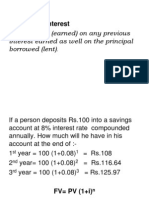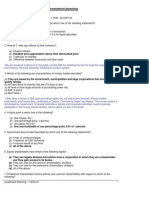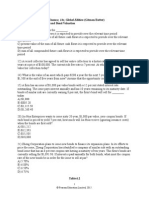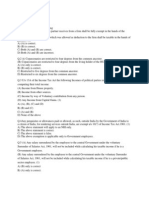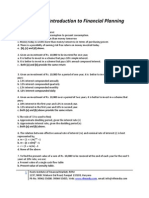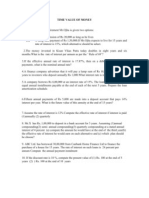FPSBI/M-VI/01-01/10/SP-21: 1 FPSB India / Public
FPSBI/M-VI/01-01/10/SP-21: 1 FPSB India / Public
Uploaded by
bhaw_shCopyright:
Available Formats
FPSBI/M-VI/01-01/10/SP-21: 1 FPSB India / Public
FPSBI/M-VI/01-01/10/SP-21: 1 FPSB India / Public
Uploaded by
bhaw_shOriginal Description:
Original Title
Copyright
Available Formats
Share this document
Did you find this document useful?
Is this content inappropriate?
Copyright:
Available Formats
FPSBI/M-VI/01-01/10/SP-21: 1 FPSB India / Public
FPSBI/M-VI/01-01/10/SP-21: 1 FPSB India / Public
Uploaded by
bhaw_shCopyright:
Available Formats
FPSBI/M-VI/01-01/10/SP-21
Case Study Anjuman Hansraj (Reference date 23rd January, 2010)
Anjuman Hansraj, aged 42 years, a Chartered Accountant is working as Director in Bilaspur unit of a
Multinational company, engaged in cement manufacturing. He is presently residing in a township of the
company situated near Bilaspur in Chhattisgarh. His wife Vaishnavi, aged 38 years, is also a Chartered
Accountant. She took up a job in a private consultancy firm in April, 2009 which gives her an annual allinclusive package of Rs. 7.50 lakh. She expects her income to rise every year by 10% p.a. They have a school
going daughter Ananti, aged 8 years.
Financial details of Anjuman:
Income for the Financial Year 2008-09:
Basic Salary
Dearness Allowance (forming part of Salary)
Bonus
Transport Allowance
Commission
Short Term Income from Share trading
:
:
:
:
:
:
Rs. 10,80,000
20% of Basic Salary
30% of basic salary
Rs. 13,200
Rs. 1,20,000
Rs. 3,56,000
:
:
Rs. 4,75,000
Rs. 50,200
Expenses
Household Expenses
Child School/Tuition
Assets valued as of today (or as specified in footnotes)
Cash/Bank
Rs. 2,50,000
Government Bonds & Debt MF
Rs. 12,00,000
PPF
Rs. 5,56,000
Gold Ornaments
Rs. 8,95,000
Car
National Savings Certificate2
:
:
Rs. 4,45,000
Rs. 4,50,000
Shares & Equity MF3
Rs. 25,00,000
:
:
:
Rs. 20,00,000
Rs. 25,00,000
Rs. 91,300
Residential House
Plot of land
Unit Linked Pension Plan5
1
in the name of Anjuman, Maturing on 1st April 2017. There has been no investment in this account in this
financial year till date. Balance as on 31st March, 2009.
2
Amount invested on 1st Jan 2009.
3
Includes XYX Equity MF (Dividend Payout option) with 11025.2356 units and present NAV of Rs. 66.324.
4
Situated at his native Bilaspur and used as a holiday home.
5
Twenty years plan, started on 15th Dec 2002 and Premium is Rs. 10,000 p.a. Next premium is due on 15th Dec
2010.
Liabilities
Nil
You, in consultation with the couple ascertain their life Goals and methodology about their achievement.
1
FPSB India / Public
FPSBI/M-VI/01-01/10/SP-21
1) Buy a house for investment purpose Immediately The cost of the house Rs. 60 lakh By selling the
plot of land and taking a bank loan repayable over 10 years @ 12% p.a. interest on monthly reducing
balance basis
2) Start a Consultancy Firm for the couple After Anjuman quits his current job at the age of 50 years
Through conversion of his Equity portfolio and Debt portfolio along with a Systematic Investment
Plan.
3) Retirement corpus On Anjumans age of 65 years Vaishnavi to invest 10% of her annual salary in
Equity and Debt in ratio of 90:10 and rebalance the accumulated amounts periodically when the
allocation to these asset classes changes.
4) Anantis Higher Education abroad 10 years from now Rs. 10 lakh per annum (current charges) for 4
years Through Systematic Monthly Investments in Nifty ETF and Gold ETF Scheme in the ratio 90:10
in the first three years, 75:25 in the next three years, 60:40 in the further three years and 100% in
Liquid Fund in the final year.
5) Anantis Marriage cost at the age of 25 years Rs. 25 lakh (current charges) Through Systematic
Monthly Investments in Gold ETF scheme and Equity MF Scheme.
6) World Tour Anjumans age of 60 years Rs. 18 lakh (current charges) Through investing PPF
maturity amount to generate suitable returns.
Assumptions
1)
2)
3)
4)
5)
6)
7)
Risk free return
Inflation
Equity
Debt
Liquid Funds
Gold
Life expectancy
a. Anjuman
b. Vaishnavi
:
:
:
:
:
:
:
:
6.50% p.a.
5.50% p.a.
11.00% p.a.
7.00% p.a.
5.50% p.a.
7.50% p.a.
85 years
87 years
2
FPSB India / Public
FPSBI/M-VI/01-01/10/SP-21
Questions
Anjuman, after seeing the use of CFPCM mark with your name, wants to know which entity in India is
licensed to award CFPCM Certification. You tell him the name of organization as ________.
(2)
1)
A)
B)
C)
D)
2)
Financial Planning Standards Board India or FPSB India
Financial Planning Standards Board of India
Financial Planning Standards Board or FPSB
Financial Planning Standards Board, India
While preparing Financial Plan for Anjuman you have ensured that all the significant
recommendations are made in writing. If any significant recommendations are given orally, then
confirmations have been given in writing. You have complied with Rule that relates to the Code of
Ethics of ________.
(2)
A)
B)
C)
D)
3)
Fairness
Diligence
Professionalism
Compliance
For the world tour of the couple at Anjumans age of 60 years, you suggest Anjuman to accumulate
funds by continuing investment in his PPF A/c. to the extent of maximum permissible limit on the first
working day of every financial year, such subscription in the current financial year to be deposited on
1st February, 2010. He should go for extension of his PPF A/c. twice after its due maturity and should
continue to invest amounts as suggested above every financial year. The final maturity proceeds
would be invested in a Liquid Fund until its utilization for world tour. Anjuman wants to know what
maximum level of average annual increase in such travel and associated costs during this period would
see the amount thus accumulated covering his goal of world tour. (Assume that the current regime in
PPF A/c. would continue)
(5)
A)
B)
C)
D)
4)
5.60% p.a.
5.83% p.a.
6.05% p.a.
6.14% p.a.
Anjuman wants to accumulate funds for Anantis higher education abroad. You suggest, apart from
monthly investments to be allocated in the ratio as proposed in individual years, the accumulated
balances in individual asset class to be rebalanced in the beginning of the block of years in line with
the allocation for that block of years. The investments should begin on 1st Feb, 2010 for a period of
10 years. The yearly withdrawals, when due, in lump sum amount nearing closest Lakh of Rupees are
effected on 1st February every year. What monthly amount in the nearest Hundred Rupees should be
invested? (Please ignore the impact of taxes and charges)
(5)
A)
B)
C)
D)
5)
Rs. 34,800
Rs. 35,300
Rs. 34,500
Rs. 33,500
You have advised Anjuman to buy a Term Insurance for his life and also for the life of Vaishnavi, he
wants to know the importance of waiver of premium rider?
(3)
A)
It is useless as there will not be any amount to be received from the Insurance Company at the
time of maturity of the policy
3
FPSB India / Public
FPSBI/M-VI/01-01/10/SP-21
B)
C)
D)
6)
It is very useful as all future premiums would be waived by the Insurance Company in case the
Life Assured becomes totally and permanently disabled
It is same as Permanent Disablement rider hence need not be mentioned separately
It is inbuilt with all the Term Insurance plans and thus need not be mentioned separately
You have mentioned to Anjuman that as you increase the tenure of insurance coverage, the premium
charged per year will also increase. You are referring to which type of Life Insurance coverage?
(2)
A)
B)
C)
D)
7)
Whole Life Insurance Plan
Endowment Plan
Unit Linked Insurance Plan
Term Plan
For Anjumans Consultancy Firm at the age of 50 years, he would require an estimated sum of Rs. 3.25
crore then, towards office premises, equipment and provision of first 2 years salary of employees to
be recruited. You suggest him to take a loan of Rs. 2 crore at that time for office premises and
renovation, repayable over a 10-year term. You further suggest him to liquidate his entire Equity
portfolio and Debt portfolio and invest the proceeds in a Balanced Mutual Fund scheme yielding 8.5%
p.a. in the next 8 years. You estimate monthly investment required w.e.f. 1st February, 2010 for a
period of 8 years in the same scheme to build the required differential corpus for his proposed
venture. The monthly investment in the nearest Hundred Rupees required is computed as
__________. (Ignore taxes payable on transactions)
(4)
A)
B)
C)
D)
8)
Rs. 12,500
Rs. 64,800
Rs. 39,700
Rs. 92,000
You have suggested Systematic Monthly Investments in Gold ETF scheme and Equity MF Scheme in
the ratio 30:70 for accumulating funds for Anantis marriage. What approximate total monthly
investments should be made in suitable instruments as above starting from 1st Feb 2010 to
accumulate the required funds?
(4)
A)
B)
C)
D)
9)
Rs. 12,000
Rs. 13,750
Rs. 11,450
Rs. 12,325
You, in consultation with Vaishnavi and Anjuman estimate that the couple would require 50% of their
current household expenses adjusted for inflation post-retirement at Anjumans age of 65 years. The
corpus to sustain such inflation-adjusted expenses to last till Vaishnavis currently estimated lifetime
should be invested in risk free instruments. Vaishnavi desires to invest 10% of her current annual
salary on 1st February, 2010 and thereafter on 1st February every year the same portion of her
increased salary to achieve this goal. You compute the accumulated corpus by mapping investments in
a ratio of 90:10 in Equity & Debt for the first five years. You alter this ratio in favour of Debt by 15%
every 5 years and also rebalance the portfolio accordingly. Your analysis shows ______________ in
the corpus to be thus accumulated.
(5)
A)
B)
C)
Surplus of 6.61 lakh
Shortfall of Rs. 47.36 lakh
Shortfall of Rs. 30.71 lakh
4
FPSB India / Public
FPSBI/M-VI/01-01/10/SP-21
D)
Almost Meeting the Target
Anjuman had invested Rs. 4 lakh on 25th Jun 2003 in XYX Equity MF. He opted for dividend payout
option and received dividends paid by the scheme at 12% each on 16/Jun/2004, 29/Dec/2005,
13/Feb/2007 and on 6/Apr/2008. Anjuman wants to know the rate of return obtained by him on this
investment. The same is _______.
(4)
10)
A)
B)
C)
D)
11)
9.00% p.a.
10.09% p.a.
11.35% p.a.
10.54% p.a.
Anjuman has identified a second house in his native Bilaspur which he can buy for Rs. 60 lakh. He
wants to dispose of the plot of land for Rs. 25 lakh. He would take a bank loan for the differential
amount available at 12% p.a. (on monthly reducing balance basis) and repayable over a 10-year
period. The property tax and maintenance outgoings for the house would be annually Rs. 43,000.
What rental income he should expect in the first year to completely offset his expenses including
interest on loan to be incurred on account of his second home? He does not intend to avail of Section
80C benefit from this property. The complete transaction including disbursal of bank loan and renting
of property may be considered to begin on 1st April, 2010.
(4)
A)
B)
C)
D)
12)
Rs. 7,18,748
Rs. 4,59,355
Rs. 5,14,000
Rs. 4,52,616
Anjuman has paid till date 7 premiums in his Unit Linked Pension Plan. He has intimated you that the
premium allocation charge was 20% in the first year, 10% in the second year, 5% from 3rd year to 5th
year, and 2% in all subsequent years to date. He wants to know his return on investment before
paying the 8th premium which he is allowed to pay till 31st January, 2010 without any penalty. He also
wishes to know the annual rate of return on his invested amount after premium allocation charge to
assess how the scheme has actually performed. You compute the same as ____ & ____.
(4)
A)
B)
C)
D)
13)
2.93% p.a. & 5.60% p.a.
3.87% p.a. & 5.23% p.a.
4.77% p.a. & 7.43% p.a.
6.65% p.a. & 8.47% p.a.
Anjuman is seriously considering surrendering his policy of Unit Linked Pension Plan. What would be
the tax implications of the surrender value received by him?
(3)
A)
B)
C)
D)
14)
Any amount received will be tax free
Amount received less the total premiums paid will be taxable at 10%
Any Amount received will be added to his income and will be taxed accordingly
Amount received less the index value of the premiums paid will be taxable at 20%
Anjuman wants to know the tax deduction on reinvestment of Interest on NSC.
A)
B)
C)
D)
(3)
Accrued interest (which is deemed as reinvested) also qualifies for deduction for 6 years.
Accrued interest (which is deemed as reinvested) also qualifies for deduction for first 5 years.
Accrued interest (which is deemed as reinvested) does not qualify for deduction.
Accrued interest (which is deemed as reinvested) also qualifies for deduction for first 3 years.
5
FPSB India / Public
FPSBI/M-VI/01-01/10/SP-21
Case Study Dr. Darshan Arora (Reference date 16th Jan, 2010)
Dr. Darshan Arora and his wife Dr. Shweeta, residents of Ahmedabad contacted you today to prepare a
Financial Plan for their family which will provide them a clear direction for achieving their financial goals.
You have gathered the couples personal and financial data to analyze their financial position.
Dr. Darshan Arora, aged 37 years, is a Gynecologist and partner in a nursing home run by three partners. As
per partnership deed all three are working partners, drawing equal salary and share profits from nursing home
in equal ratio. His wife Dr. Shweeta, age 36 years, is an Anaesthesiologist and associated with different
Hospitals. The Couple has two children, daughter Iravati aged 9 years and son Nishant, aged 5 years. Dr.
Darshans father passed away few years ago. The couple is supporting Dr. Darshans mother, aged 66 years,
currently to the extent of Rs 12,000 p.m. Dr. Darshans mother stays in a house at Nasik with her younger son
Pardeep Arora.
For the Financial Year 2008-09:
Net Income
Dr. Darshan (Share of Profit from Partnership Firm)
Dr. Darshan (Salary receipt from Partnership Firm)
Dr. Shweeta (Consultancy fees)
:
:
:
Rs. 9.00 lakh
Rs. 3.40 lakh
Rs. 6.50 lakh
:
:
Rs. 5.40 lakh
Rs. 1.80 lakh
Expenses
Household
Childrens Education
Assets valued closest to 16th Jan, 2010 (or as specified otherwise)
Particulars
Residential House
Present Market Value
Equity Shares
Present Market Value
Equity Mutual Funds
Present Market Value
Debt Mutual Funds
Present Market Value
Public Provident Fund( A/c opened Balance as on 1st April 2009
as on 28 March 2005)
Gold Ornaments
Present Market Value
Cash & Bank Balance
Car
Present Market Value
Zero coupon Bonds#
Face Value
ULIP Policy (First premium paid as Premium paid
on 1st Feb 2002)
# 5 Year term; 500 bonds of Face Value Rs. 1,000 each, maturing on 15/01/2012.
Amount (in Rs.)
45,00,000
4,50,000
1,80,000
2,25,000
4,15,000
7,50,000
3,22,000
5,50,000
5,00,000
4,80,000
Outstanding Liabilities closest to 16th Jan, 2010
Particulars
Car Loan
Personal Loan
Principal
Principal
Amount (in Rs.)
2,02,500
2,80,000
6
FPSB India / Public
FPSBI/M-VI/01-01/10/SP-21
Dr. Arora has also been investing Rs. 60,000 p.a. in a Unit Linked Insurance Plan for the last 8 years. The sum
assured is Rs. 15 Lakh under this policy and the term is 20 years. He opted for growth fund in this policy for
first four years and balance fund for remaining term of the policy. As per terms of ULIP policy in case of
death, sum assured plus outstanding fund value is given to beneficiary.
You, in consultation with the couple, arrive at their Life Goals and give the following roadmap to achieve the
same.
1) The couple wants to start a nursing home of their own after 5 years from now. They wish to buy a
ready commercial property immediately which is available for Rs. 1 crore. They want to take a loan for
a term of 5 years for this and rent out the property as soon as the possession is secured. The current
rent for similar property in the area is Rs. 35,000 p.m. After 5 years, they wish to demolish the
structure in order to build their nursing home at the spot. The nursing home entails a current
construction cost of Rs. 2 crore.
2) For Medical education of their children, they would need funds on the date children complete 18
years of their age for a term of four years of Graduation and further term of two years of Post
Graduation. Present cost of Graduation per child is Rs. 8 lakh in the first year and 2 lakh p.a. for the
next three years. For Post Graduation current cost is Rs. 4 lakh p.a. for two years.
3) Shift to a bigger Residential House worth Rs.80 Lakh in present terms after five years.
4) Accumulate Rs. 15 Lakh (in present terms) for Iravatis Marriage expenses at the age of 25 years
through regular contribution in his existing PPF account.
5) Build a retirement corpus till Dr. Darshan completes 58 years, for household expenses in his post
retirement period which would be equal to 60% of pre-retirement household expenses.
Assumptions
1)
2)
3)
4)
5)
6)
7)
8)
9)
Risk free return
Inflation
Return on Equity/ Equity MF
Return on Debt/ Debt MF
Return on Liquid Funds
Return on ULIP- Growth fund
Return on ULIP- Balance fund
Gold
Life expectancy
a. Darshan
:
b. Shweeta
:
:
:
:
:
:
:
:
:
6.50% p.a.
5.50% p.a.
11.00% p.a.
7.00% p.a.
6.00 % p.a.
10.00 % p.a.
8.00% p.a.
7.50% p.a.
80 years
80 years
7
FPSB India / Public
FPSBI/M-VI/01-01/10/SP-21
Questions
15)
Dr. Darshan is not satisfied with the returns generated by his ULIP. He wants to surrender his ULIP to
use the proceeds to pre-pay his Personal Loan. A premium allocation charge applicable in the policy is
20% for the first year, 10% for the next 2 years and 5 % for the remaining term of the policy. Mortality
Charge of Rs. 1.95 per thousand Sum Assured and administrative charges Rs. 480 p.a. charged in the
beginning of the year from the fund value and is fixed for the whole term of the policy. Fund
management charges 1.75% of closing fund value is deducted at the end of every year. He wants to
know from you, what should be the surrender value of his policy if no surrender charges are
applicable?
(4)
A)
B)
C)
D)
16)
A)
B)
C)
D)
17)
You have advised Dr. Darshan to purchase an insurance policy on his residential property. Dr. Darshan
purchased the plot of land 5 years ago for Rs. 14 Lakh. He incurred Rs. 15 Lakh on construction of this
house three years ago. The land prices in that area have appreciated by 20% p.a. over the five year
period and the cost of construction over the last three years has gone up by 8% year-on-year. The rate
of deprecation on building is 6 % p.a. You have advised him to insure his house property. You compute
the value for which Dr. Darshan should insure his house property on reinstatement basis as ______.
(4)
Rs. 15.70 Lakh
Rs. 18.90 Lakh
Rs. 10.16 Lakh
Rs. 45.00 Lakh
You have advised Dr. Darshan to use his PPF account exclusively for accumulating part of the funds for
the marriage of his daughter Iravati. For this purpose, you have advised him to contribute the
maximum permissible investment limit in PPF A/c. on the last working day of every financial year from
now onwards till the original term expires in this PPF account. After the original maturity, the account
should be extended for a term of 5-year block but without any contribution in the extended period.
Dr. Darshan wants to know what maturity amount he will get from this account at the end of the
extended period. No contribution has been made till date in the account for this financial year.
Assume that the current PPF A/c. regime continues for the whole period.
(5)
A)
B)
C)
D)
18)
Rs. 5.55 Lakh
Rs. 6.04 Lakh
Rs. 5.23 Lakh
Rs. 6.12 Lakh
Rs. 31.33 Lakh
Rs. 28.06 Lakh
Rs. 27.19 Lakh
Rs. 26.05 Lakh
What would be the correct sequence to perform six steps of Financial Planning process to prepare a
Financial Plan for Dr. Darshan?
1. Developing and Presenting the Financial plan
2. Analyzing and evaluating the clients financial status
3. Implementing the Financial Plan
4. Monitoring the Financial Plan
5. Establishing Client-Planner Relationships
8
FPSB India / Public
FPSBI/M-VI/01-01/10/SP-21
6. Gather client data and determining Goals and Expectations
A)
B)
C)
D)
19)
Yield to call is 8.34% p.a.
Yield to put is 7.83 % p.a.
Yield to put is 8.34% p.a.
Yield to call is 7.83% p.a.
Dr. Darshan saw your name with CFP Marks. He wants to know the different ways in which the CFP
Marks in India can be used with the name of professional.
i)
Certified Financial PlannerCM
ii)
CFPCM
iii)
CFPcm
iv)
C.F.P.
v)
CFPCM
vi)
CERTIFIED FINANCIAL PLANNERCM
(2)
A)
B)
C)
D)
21)
i) ,ii),v) & vi)
ii) & vi)
iv), v) & vi)
ii), v) & vi)
Dr. Darshan wants to know from you, what is his tax liability for AY 2009-10. You have observed that
taxable Income from other sources is Rs. 85,000 and he has made investments/payments to claim
maximum deduction u/s 80C. Dr. Darshan has not purchased any mediclaim policy. According to you
his Income Tax liability for AY 2009-10 would be ___________.
(5)
A)
B)
C)
D)
22)
1, 3, 4, 5, 2, 6
6, 2, 5, 4, 3, 1
6, 5, 2, 1, 3, 4
5, 6, 2, 1, 3, 4
The bonds included in the familys portfolio were issued at Rs. 670 per bond. The bond also has an
inbuilt option that after 3 years the investor can ask for repayment and company shall refund Rs. 840
on each bond. Dr. Darshan wants to know the yield if he asks for repayment after three years.
(2)
A)
B)
C)
D)
20)
(3)
Rs. 23,690
Rs. 20,600
Rs. 3,08,740
Rs. 41,200
Dr. Darshan wants a monthly investment to achieve the goal of his children's higher education. For
accumulation of fund you recommend Dr. Darshan to invest in an investment vehicle which invests in
the ratio of 30:70 in Debt MF scheme and Equity MF scheme. If Dr. Darshan starts investing from 1st
Feb 2010, what approximate amount he should invest every month till they individually complete 18
years of age, for each child to achieve that goal? Dr. Darshan maintains separate investment accounts
for Iravati and Nishant. You further advise him to redeem corpus of each account when the time child
completes 18 years of age and invest the combined sum of Equity scheme and Debt scheme into a
Liquid mutual fund scheme.
(5)
9
FPSB India / Public
FPSBI/M-VI/01-01/10/SP-21
A)
B)
C)
D)
23)
Rs. 20,655 and Rs. 14,166 respectively
Rs. 22,870 and Rs. 16,310 respectively
Rs. 13,000 and Rs. 7,200 respectively
Rs. 18,590 and Rs. 13,015 respectively
Dr. Darshan has informed you that post interest (at the rate of 12% p.a.) and salary to the partners (as
stipulated in the partnership deed) his professional firm has earned a net profit before tax of Rs. 38.60
lakh in FY 2008-09. To get an idea of optimum tax planning for future years, Dr. Darshan wants to
know the maximum salary allowable in FY 2008-09 as per the provisions of Income Tax Act, 1961? (4)
A)
B)
C)
D)
24)
Rs. 6,68,170
Rs. 6,74,000
Rs. 5,32,170
Amount specified in partnership deed is allowed
You have advised Dr. Darshan to accumulate his retirement corpus by investing an equal amount
every month in Equity Mutual Fund scheme and Debt Mutual Fund scheme. You further advise to
rebalance the accumulated funds across both the schemes in equal proportion after every seven
years. After his retirement at the age of 58 years, he would switch the accumulated corpus of Equity
scheme into Debt scheme in order to generate an inflation-linked monthly annuity till his expected
lifetime. He would require the annuity amount, in the first month after retirement, equal to 60% of
pre-retirement expenses. What equal monthly amount should he invest in each of Equity and Debt
schemes starting from today?
(5)
A)
B)
C)
D)
25)
Rs. 7,505
Rs. 12,375
Rs. 13,055
Rs. 13,773
Dr. Darshan took personal loan at 16% p.a. rate of interest (reducing monthly balance basis) for tenure
of 42 months. The installments are payable on the 15th of every month. Seven installments are yet to
be paid. The foreclosure charges are 3% of the outstanding amount. You suggest him to pre-pay the
loan at this stage by surrendering his ULIP Policy. Dr. Darshan wants to know from you what would be
the amount (net of penalty charges) he can save by pre-paying his personal loan. (Please ignore taxes
on charges, if applicable)
(3)
A)
B)
C)
D)
26)
Rs. 6,731
Rs. 15,131
Rs. 12,500
Rs. 10,400
For the deal of commercial property for their proposed Nursing Home in future, Dr. Darshan wishes to
avail of a Bank Loan for Rs. 90 Lakh after arranging Rs. 10 lakh for down payment by disposing of his
Equity and Debt Portfolio and balance from his bank account. The loan at 9.5% p.a. fixed rate of
interest (reducing monthly balance basis) is to be taken for 5 years. What percentage of interest
expended in the first year on such a loan is to be offset by the expected rental receipts?
(3)
A)
B)
C)
19%
48%
53%
10
FPSB India / Public
FPSBI/M-VI/01-01/10/SP-21
D)
27)
49%
In the initial stage of Financial Plan preparation, you told Dr. Darshan and also mentioned in the
Financial Plan prepared that you would charge fixed fee for the Financial Plan construction and you
would also earn commission on sale of recommended financial products, if the same is accepted.
Which code of ethics binds the CFPCM Practitioner to disclose conflict of interests?
(3)
A)
B)
C)
D)
28)
Objectivity
Fairness
Integrity
Professionalism
Dr. Darshan wants to know what the After Tax Real Rate of Return is in case of investment in an Equity
MF scheme and Debt MF scheme, if the investment is withdrawn after completion of one year. Take
assumptions on absolute rates on individual asset classes and inflation as given, and consider without
indexation tax rates.
(2)
A)
B)
C)
D)
Equity 5.50% p.a., Debt 0.80% p.a.
Equity 5.21% p.a., Debt 0.76% p.a.
Equity 5.50% p.a., Debt 1.50% p.a.
Equity 5.21% p.a., Debt 1.42% p.a.
11
FPSB India / Public
You might also like
- Bonds and Stock CWDocument4 pagesBonds and Stock CWMunazza Jabeen40% (5)
- Ch5Probset Bonds+Interest 13ed. - MasterDocument8 pagesCh5Probset Bonds+Interest 13ed. - Masterpratiksha1091No ratings yet
- Investment Planning FINAL PDFDocument84 pagesInvestment Planning FINAL PDFs_hirenNo ratings yet
- CFP Certification Exam Sample Paper WWW - Fpsb.co - in Financial Planning Standards BoardDocument12 pagesCFP Certification Exam Sample Paper WWW - Fpsb.co - in Financial Planning Standards BoardtarangtgNo ratings yet
- March Case StudyDocument11 pagesMarch Case StudysinhapushpanjaliNo ratings yet
- Sanjay Case Study 2017 QsDocument3 pagesSanjay Case Study 2017 QsIBBF FitnessNo ratings yet
- CFP RaipDocument3 pagesCFP RaipsinhapushpanjaliNo ratings yet
- Sample Questions - Challenge Status - CFPDocument13 pagesSample Questions - Challenge Status - CFPBronil W DabreoNo ratings yet
- Review Extra CreditDocument8 pagesReview Extra CreditMichelle de GuzmanNo ratings yet
- Investment Planning Mock Test: Practical Questions: Section 1: 41 Questions (1 Mark Each)Document17 pagesInvestment Planning Mock Test: Practical Questions: Section 1: 41 Questions (1 Mark Each)its_different17No ratings yet
- TestDocument47 pagesTestsamcool87No ratings yet
- 6.1 Code of EthicsDocument66 pages6.1 Code of EthicsViplav RathiNo ratings yet
- Time Value of MoneyDocument30 pagesTime Value of MoneyAshia12No ratings yet
- IFP Module.Document99 pagesIFP Module.Shah DhaivatNo ratings yet
- RTPBDocument87 pagesRTPBKr PrajapatNo ratings yet
- CFP - SuggestedSolutions - RPEBDocument6 pagesCFP - SuggestedSolutions - RPEBSODDEYNo ratings yet
- Inv PLNGDocument78 pagesInv PLNGapi-38145570% (1)
- Chapter Five Investment PolicyDocument14 pagesChapter Five Investment PolicyfergiemcNo ratings yet
- Exam4 PastCaseStudy 2010Document46 pagesExam4 PastCaseStudy 2010Namrata PrajapatiNo ratings yet
- Chapter 6 Exercises (Bonds & Interest)Document2 pagesChapter 6 Exercises (Bonds & Interest)Shaheera SuhaimiNo ratings yet
- CH 2Document4 pagesCH 2Sayandeep Nag0% (1)
- Intro Practice Book Sample FPDocument35 pagesIntro Practice Book Sample FPnaresh2011No ratings yet
- Testkingpdf: Valid Test Online & Stable Pass King & Latest PDF DumpsDocument19 pagesTestkingpdf: Valid Test Online & Stable Pass King & Latest PDF DumpsRamkrishana PathakNo ratings yet
- Cap 1Document74 pagesCap 1Mej Beit Chabab100% (1)
- WM QuizDocument19 pagesWM QuizajazahmedNo ratings yet
- Ashwini Agarwal Age34 - Case - A - MasterDocument61 pagesAshwini Agarwal Age34 - Case - A - MasterAmit GuptaNo ratings yet
- Portfolio Management Extra Practice QuestionsDocument17 pagesPortfolio Management Extra Practice QuestionsVANDANA GOYALNo ratings yet
- Investor Profile QuestionnaireDocument4 pagesInvestor Profile QuestionnaireSubbu JustcoolNo ratings yet
- Assignment - 1 Time Value of MoneyDocument1 pageAssignment - 1 Time Value of MoneyPradnya WadiaNo ratings yet
- FPSB India - Retirement Module Sample Paper - Simplified Solution Using Calculator - March 2013Document9 pagesFPSB India - Retirement Module Sample Paper - Simplified Solution Using Calculator - March 2013Krupa VoraNo ratings yet
- Iapm SolutionsDocument81 pagesIapm Solutionsjayaram_polarisNo ratings yet
- CFP Sample Paper Tax PlanningDocument4 pagesCFP Sample Paper Tax PlanningamishasoniNo ratings yet
- 9 CFP Exam5-Afp-2008 Case Studies PDFDocument130 pages9 CFP Exam5-Afp-2008 Case Studies PDFankur892No ratings yet
- CHALLENEGE STATUS-Sample Paper Stage 1Document26 pagesCHALLENEGE STATUS-Sample Paper Stage 1Neelam Jain100% (1)
- Questions Case StudyDocument4 pagesQuestions Case StudyKrupa VoraNo ratings yet
- Risk and Insurance 2Document61 pagesRisk and Insurance 2amrut85100% (1)
- DocDocument6 pagesDoctai nguyenNo ratings yet
- Insurance CFPDocument166 pagesInsurance CFPAbhinav Mandlecha100% (1)
- Practice Qs 2Document24 pagesPractice Qs 2SANCHITA PATINo ratings yet
- Understanding The Concept of InvestmentDocument17 pagesUnderstanding The Concept of InvestmentSUDHIRNo ratings yet
- Investment and Portfolio Management Session 3 QuestionsDocument2 pagesInvestment and Portfolio Management Session 3 Questions李佳南No ratings yet
- Question Paper Security Analysis - I (211)Document22 pagesQuestion Paper Security Analysis - I (211)Raghavendra Rajendra Basvan100% (1)
- Investment Adviser Level1 Study NotesDocument39 pagesInvestment Adviser Level1 Study NotesP R ChandanNo ratings yet
- Question Paper Security Analysis I (211)Document21 pagesQuestion Paper Security Analysis I (211)Raghavendra Rajendra BasvanNo ratings yet
- Case Study For CFPDocument1 pageCase Study For CFPsinghanshu21100% (2)
- CFP Mock Test Introduction To Financial PlanningDocument7 pagesCFP Mock Test Introduction To Financial PlanningDeep ShikhaNo ratings yet
- Ref Date 1/4/17 Sahanubhuti SP-2 Pattern Question Bank (15 Questions: 2 HRS)Document4 pagesRef Date 1/4/17 Sahanubhuti SP-2 Pattern Question Bank (15 Questions: 2 HRS)preeti chhatwalNo ratings yet
- Sahanubhuti UniqueDocument10 pagesSahanubhuti UniquePrashanth JogimuttNo ratings yet
- 017 Sep 09 AvinashDocument11 pages017 Sep 09 Avinashdeepak goyalNo ratings yet
- Problems-Financial ManagementDocument13 pagesProblems-Financial ManagementGajendra Singh Raghav50% (2)
- Homework QuestionsDocument6 pagesHomework Questionsgaurav shetty100% (1)
- Financial Planning and Wealth Management kXHmbbjRDUDocument13 pagesFinancial Planning and Wealth Management kXHmbbjRDUgoel.animesh105No ratings yet
- FPWM - Time Value of Money QuestionsDocument4 pagesFPWM - Time Value of Money QuestionsvuppalashrimanthNo ratings yet
- 0ecd7tvm AssignDocument1 page0ecd7tvm AssignAman WadhwaNo ratings yet
- Probable Solution For Questions Asked - Current Batch - March 2015Document30 pagesProbable Solution For Questions Asked - Current Batch - March 2015aditiNo ratings yet
- Time Value of MoneyDocument14 pagesTime Value of MoneyRakesh Gupta100% (2)
- CF Assignment - 2Document2 pagesCF Assignment - 2vishnu607No ratings yet
- Financial Planning and Wealth ManagementDocument3 pagesFinancial Planning and Wealth Managementgoel.animesh105No ratings yet
- Time Value of MoneyDocument8 pagesTime Value of MoneySocio Fact'sNo ratings yet
- FPSB India / Public 1: FPSBI/M-VI/04-01/09/SP-12Document13 pagesFPSB India / Public 1: FPSBI/M-VI/04-01/09/SP-12bhaw_shNo ratings yet
- Financial Planning: Step 1: "Letter of Engagement" Is A Professional Requirement Under Practice GuidelinesDocument7 pagesFinancial Planning: Step 1: "Letter of Engagement" Is A Professional Requirement Under Practice Guidelinesbhaw_shNo ratings yet
- Planning & EstateDocument5 pagesPlanning & Estatebhaw_shNo ratings yet
- Guidance Notes 2Document12 pagesGuidance Notes 2bhaw_shNo ratings yet
- FPSBI/M-VI/01-01/10/SP-21: 1 FPSB India / PublicDocument11 pagesFPSBI/M-VI/01-01/10/SP-21: 1 FPSB India / Publicbhaw_shNo ratings yet
- WN - 2Document6 pagesWN - 2bhaw_shNo ratings yet












